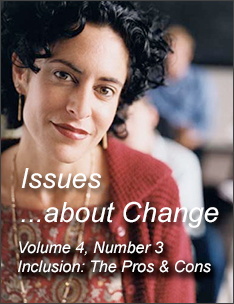References
- Board of Education, Sacramento Unified School District v. Holland, 786 F. Supp 874, 73 Ed. Law Rep. 969 (E.D.Cal. 1992).
- Boyd-Dimock, V. (1992). Creating a text for change. Issues . . . about Change, 2(2). Austin, TX: Southwest Educational Development Laboratory. Retrieved from http://www.sedl.org/change/issues/issues22.html
- CEC policy on inclusive schools and community settings. (1993). Teaching Exceptional Children, 25(4) (Supplement).
- Cohen, O. (1994, April 20). 'Inclusion' should not include deaf students. Education Week, 13(30), 35.
- Daniel RR v. State Board of Education, 874 F.2d 1036 (5th Cir. 1989).
- Erwin, E. J. (1993, Winter). The philosophy and status of inclusion. Envision: A publication of The Lighthouse National Center for Vision and Child Development, 1, 3-4.
- Greer v. Rome City School District, 950 F. 2d 688 (11th Cir. 1991).
- Heubert, J. (1994, July/August). Assumptions underlie arguments about inclusion. Harvard Education Newsletter, 10(4), 4.
- Hord, S. M., & Czerwinski, P. (2000, Revised). Leadership: An imperative for successful change. Issues . . . about Change, 1(2). Austin, TX: Southwest Educational Development Laboratory. Retrieved from http://www.sedl.org/change/issues/issues12/issues-v1n2.pdf
- Kids count data book: State profiles of child well-being. (1994). Greenwich, CT: The Annie E. Casey Foundation.
- Leo, J. (1994, June 27). Mainstreaming's 'Jimmy problem.' U. S. News & World Report, 116(25), 22.
- Lieberman, L. M. (1992). Preserving special education . . . for those who need it. In W. Stainback, & S. Stainback (Eds.), Controversial issues confronting special education: Divergent perspectives. Boston: Allyn and Bacon.
- Lipsky, D. K., & Gartner, A. (1992). Achieving full inclusion: Placing the student at the center of educational reform. In W. Stainback, & S. Stainback (Eds.), Controversial issues confronting special education: Divergent perspectives. Boston: Allyn and Bacon.
- Lyon, R., & Vaughn, S. (1994). Inclusion: Can it work for students with learning disabilities? Unpublished manuscript.
- McCaul, E. J., Donaldson, G. A., Jr., Coladarci, T., & Davis, W. E. (1992). Consequences of dropping out of school: Findings from high school and beyond. Journal of Educational Research, 85(4), 198-207.
- McGregor, G. (1993, Fall). Inclusion: A powerful pedagogy. Front Line, 2(1), 8-10.
- National Association of State Boards of Education. (1992, October). Winners all: A call for inclusive schools. (Report of NASBE Study Group on Special Education). Alexandria, VA: Author.
- Oberti v. Board of Education of the Borough of Clementon School, 995 F. 2d 1204 (3rd Cir. 1993).
- O'Neil, J. (1993, November). Inclusive education gains adherents. ASCD Update, 35(9), 1, 3-4.
- Reynolds, M. C. (1988, Winter). Past, present, and future of school integration. Minnesota UAP Impact, 1(2), 2. Minneapolis: University of Minnesota, Affiliated Program on Developmental Disabilities.
- Reynolds, M. C. (1988). A reaction to the JLD special series on the regular education initiative. Journal of Learning Disabilities, 21(6), 352-356.
- Reynolds, M. C., & Birch, J. W. (1988). Adaptive mainstreaming: A primer for teachers and principals (3rd ed.). New York: Longman.
- Ringer, L., & Kerr, S. (1988, Winter). Integration-the legal imperative. Minnesota UAP Impact, 1(2), 2. Minneapolis: University of Minnesota, Affiliated Program on Developmental Disabilities.
- Rogers, J. (1993, May). The inclusion revolution. Phi Delta Kappan Research Bulletin, (11), 1-6.
- Sailor, W. (1989). The educational, social, and vocational integration of students with the most severe disabilities. In D. K. Lipsky & A. Gartner (Eds.), Beyond separate education (pp. 53-74). Baltimore: Paul H. Brookes.
- Sklaroff, S. (1994, January 12). A.F.T. urges halt to 'full inclusion' movement. Education Week, 13(16), 7.
- Skrtic, T. M. (1991, May). The special education paradox: Equity as the way to excellence. Harvard Educational Review, 61(2), 148-206.
- Soffer, R. (March/April, 1994). Inclusion-It's not what you think. ATPE News 14(4), 24, 28.
- Stainback, W., & Stainback, S. (1988, Winter). The role of research in integration. Minnesota UAP Impact, 1(2), 2. Minneapolis: University of Minnesota, Affiliated Program on Developmental Disabilities.
- Stainback, W., Stainback, S., and Bunch, G. (1989). A rationale for the merger of regular and special education. In S. Stainback, W. Stainback, & Forest, M. (Eds.), Educating all students in the mainstream of regular education. Baltimore: Paul H. Brookes.
- Stainback, W., Stainback, S., and Bunch, G. (1989). Introduction and historical background. In S. Stainback, W. Stainback, & Forest, M. (Eds.), Educating all students in the mainstream of regular education. Baltimore: Paul H. Brookes.
- Staub, D., & Peck, C. A. (1994, December-1995, January). What are the outcomes for non-disabled students? Educational Leadership, 52(4), 36-40.
- Tompkins, R., & Deloney, P. (1994). Rural students at risk in Arkansas, Louisiana, New Mexico, Oklahoma, and Texas. Austin, TX: Southwest Educational Development Laboratory.
- Tornillo, P. (1994, March 6). A lightweight fad bad for our schools? Orlando Sentinel.
- Will, M. (1986, November). Educating students with learning problems-a shared responsibility. Washington, DC: Department of Education, Office of Special Education and Rehabilitative Services.
- Winzer, M. A. (1993). The history of special education: From isolation to integration. Washington, DC: Gallaudet University Press.
Next Page: Credits & Disclaimers
Published in
Issues ...about Change
Volume 4, Number 3,
Inclusion: The Pros and Cons (1995)

